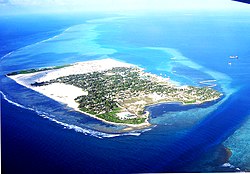Depopulation of Havaru Thinadhoo
[5] The island was renowned for its frequent trips and its wealth enabled the southern atolls of Maldives to form a nascent thalassocracy.
[7] Ibrahim Nasir, along with army personnel, subsequently travelled to Thinadhoo on a gunboat and attacked the residents, arresting the alleged leaders of the United Suvadive Republic present at the time.
[8] The United Kingdom expressed their disapproval of the Maldivian government due to the violent attack against the residents of Huvadu on August 7, 1959.
All photos and videos related to the incident involving Maldives Prime Minister Ibrahim Nasir and Thinadhoo are connected to the first uprising.
[10] The second uprising began as a result of several laws enacted in the Maldives that had a significant impact on the merchants of Havaru Thinadhoo.
New legislation was passed authorizing the imprisonment, confiscation of all money, and destruction of the houses of anybody who publicly opposed the United Suvadive.
The population of Huvadhoo atoll, especially Thinadhoo, was split in their support for the United Suvadive Republic but was hesitant to express their dissent owing to the law.
According to inhabitants of Gaddhoo, supporters of the United Suvadive ransacked the island, ruined its properties, and beat its residents because of their disagreement.
[13] On January 30, 1962, at around 2:30 to 3 PM, the vessel named "Silvercrest", commanded by Prime Minister Ibrahim Nasir, arrived at Havaru Thinadhoo.
[17] When Prime Minister Ibrahim Nasir ordered his men to the island, some locals went into shock, vomited, and later died due to the trauma of hearing gunshots and witnessing the destruction of boats and buildings.
Shocked residents watched as the leaves and branches of breadfruit trees near the Vaaruge (Tax House) splintered, and birds flew away in response to the noise.
[10] After the failed attempts to capture dhoanis, Zakariya Moosa, who was taken hostage from one of the boats, was brought to Thinadhoo to send another warning.
[18] After arriving on the island, Prime Minister Ibrahim Nasir instructed Zakariya Moosa to demand Thinadhoo's surrender and to raise the Maldives flag.
Thinadhoo residents and United Suvadive leaders were given the option to surrender by coming to Silvercrest, with the promise of no harm and forgiveness.
However, his efforts were unsuccessful as the elders were concerned about the potential consequences of the new legislation and feared losing their possessions if they were apprehended by United Suvadive supporters.
[20] In the evening, Abdul Wahhab and Mohamed Hussain left unnoticed by the United Suvadive Thinadhoo supporters on a small boat called Bokkura, which was headed towards Silvercrest.
[20] After reports surfaced about Abdul Wahhab and Mohamed Hussain's meeting on Silvercrest, United Suvadive supporters in Thinadhoo expressed hostility towards their residences.
As it approached the island, it set fire to a large ship called "Fathuhul Mubarak," which was anchored outside and belonged to Havaru Thinadhoo Naib Ismail Didi.
[15] Abdul Wahhab attempted to climb the flagpole and untie the flag, but he was repeatedly pelted with stones by United Suvadive supporters, preventing him from completing the task.
According to Ali Rasheed, he had attempted to lower the flag earlier, but was unable to do so due to gunfire exchanged between the "Madursathul Ameer Ibrahim" building and the location of the flagpole.
[10] During the depopulation, soldiers forced all the residents of the island, including women, children, and the elderly, to stand in shallow water up to their necks.
[10][23] After the depopulation, the Maldives government's official publication "Viyafaari Miyadhu" declared that "Havaru Thinadhoo island had no more inhabitants or houses.
[27] Abdul Salaam Arif, the Chief Ombudsperson, has stated that it will be difficult to uncover the truth if the investigation into the Thinadhoo case is solely focused on its depopulation.
[27] He stated that the office explored various venues for the hearing and ultimately decided to expand the scope of public testimony, noting that if the investigation solely focused on the depopulation of Thinadhoo, it would be challenging to uncover the truth.
[27] The Thinadhoo Council has requested that the building previously owned by former Prime Minister Ibrahim Nasir, which was seized by the state, be renamed as "GDh.
[27] The Thinadhoo Council has made several requests, including renaming the confiscated building of former Prime Minister Ibrahim Nasir as "GDh.




